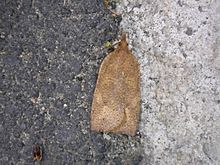Greenheaded leafroller facts for kids
Quick facts for kids Greenheaded leafroller |
|
|---|---|
 |
|
| Scientific classification | |
| Kingdom: | |
| Phylum: | |
| Class: | |
| Order: | |
| Division: | |
| Section: |
Cossina
|
| Family: | |
| Genus: |
Planotortrix
|
| Species: |
P. excessana
|
| Binomial name | |
| Planotortrix excessana (Walker, 1863)
|
|
| Synonyms | |
|
|
The Planotortrix excessana, also known as the greenheaded leafroller, is a type of moth. It belongs to the family Tortricidae, which are often called leafroller moths.
This moth is originally from New Zealand. However, it has also been introduced to Hawaii. The greenheaded leafroller moth can look very different from one moth to another. Its caterpillars eat many different kinds of plants, both native and introduced. Sometimes, this moth is considered a pest because it can damage farm crops and trees.
Contents
Discovering the Greenheaded Leafroller Moth
This moth was first officially described in 1863 by a scientist named Francis Walker. He studied a moth collected in Nelson and gave it the name Teras excessana.
Later, in the same year, Walker described the moth again, thinking it was a new species. He called it Teras biguttana. However, another scientist, Edward Meyrick, realized in 1883 that these were actually the same moth. So, Teras biguttana became a synonym, meaning it's another name for the same species.
In 1928, George Hudson wrote about and drew pictures of this moth in his book, The Butterflies and Moths of New Zealand.
What Does the Greenheaded Leafroller Moth Look Like?
The greenheaded leafroller moth can vary a lot in size and color. Its wingspan can be from about 2.2 cm (0.87 inches) to 3.2 cm (1.25 inches).
Male Moths
Male moths usually have forewings that are reddish-brown. These wings might have faint, dark markings. They can also have a large white or pale yellow spot on their forewings. Some males might even have yellowish wings with dark brown patterns.
Female Moths
Female moths are even more varied in their appearance than males. Their forewings are often longer and narrower. They can be bright orange-brown, sometimes with no clear markings. Other females might have orange-brown wings with many dark brown speckles. Some females have warm brown wings with black spots. They might also have yellowish-brown wings with clear dark patches.
Telling Them Apart
It can be tricky to tell P. excessana apart from other similar moths like P. avicenniae and P. octo. P. excessana often has warmer colors and more patterns. Many Planotortrix moths, including some P. excessana, have a diamond-shaped white or cream patch on their forewings.
Eggs and Larvae
The eggs of P. excessana look opaque, meaning you can't see through them. The larvae, which are the caterpillars, are entirely green.
Where Do Greenheaded Leafroller Moths Live?
This moth is native to New Zealand. It can be found all over the country, including on the Chatham Islands. It is a very common moth there.
It has also been introduced to Hawaii. In Hawaii, it is considered an invasive species, meaning it's not native and can sometimes harm the local environment.
Life Cycle and Behavior
The greenheaded leafroller moth has several generations each year. This means they can complete their life cycle from egg to adult multiple times in one year.
Female moths lay their eggs in a flat, oval-shaped group. Each group can have about 50 eggs. When the larvae (caterpillars) hatch, they build a silk shelter on the underside of leaves. As they grow, they create a structure by webbing leaves together. This structure becomes their home. If they are disturbed, they can drop down from their shelter, hanging by a silk thread. The larvae then turn into pupae inside this leafy structure.
What Do They Eat?
The caterpillars of the greenheaded leafroller moth eat many different kinds of plants. They feed on shrubs and trees found in forests, orchards, and gardens. They especially like trees with broad leaves or needles.
Their host plants include both introduced species and plants native to New Zealand. Some examples are Eucalyptus trees, Sequoia sempervirens (redwood), Pinus trees (like Pinus radiata), and Pseudotsuga menziesii. They also feed on New Zealand native plants such as Dicksonia squarrosa, Metrosideros diffusa, and Peraxilla tetrapetala.
How Do They Affect Humans?
In New Zealand, the greenheaded leafroller moth is a major pest for certain crops. It can cause problems for apples, strawberries, stone fruits (like peaches and plums), and walnuts. The caterpillars eat leaves, buds, and soft stems, often under a protective silk webbing.
They can also cause scars on fruits like apples and kiwifruit. This damage can make the fruit unsuitable for selling or exporting. Farmers sometimes use insecticide sprays to control these moths.
Interestingly, the moth can also be controlled by a solitary wasp called Ancistrocerus gazella. This wasp was accidentally brought to New Zealand. Scientists have suggested using this wasp as a biological control agent. This means using a natural enemy to help reduce the moth population. This method could help farmers use fewer insecticides.
Sometimes, P. excessana moths have been found at ports in the United States on plants coming from New Zealand.
Images for kids

